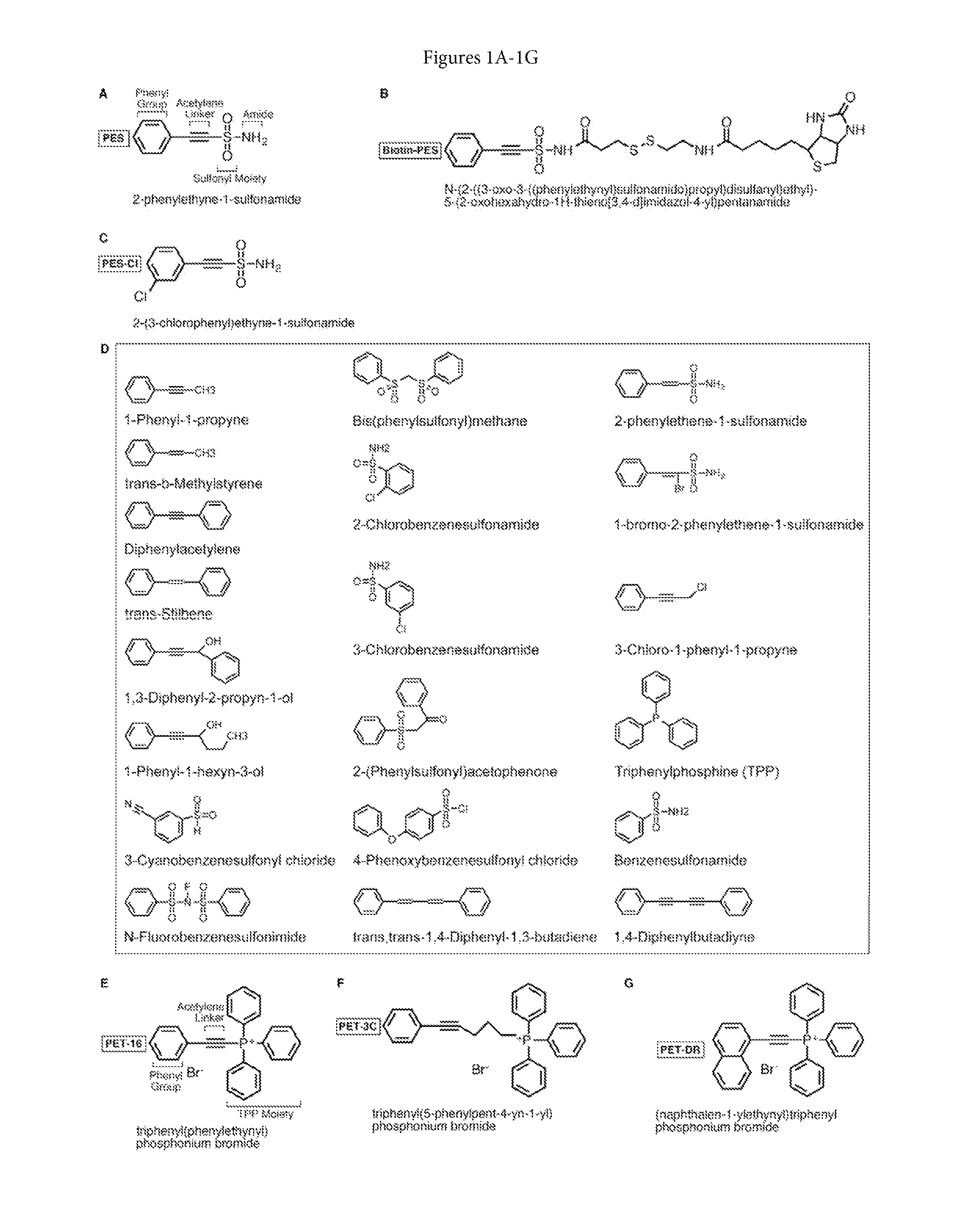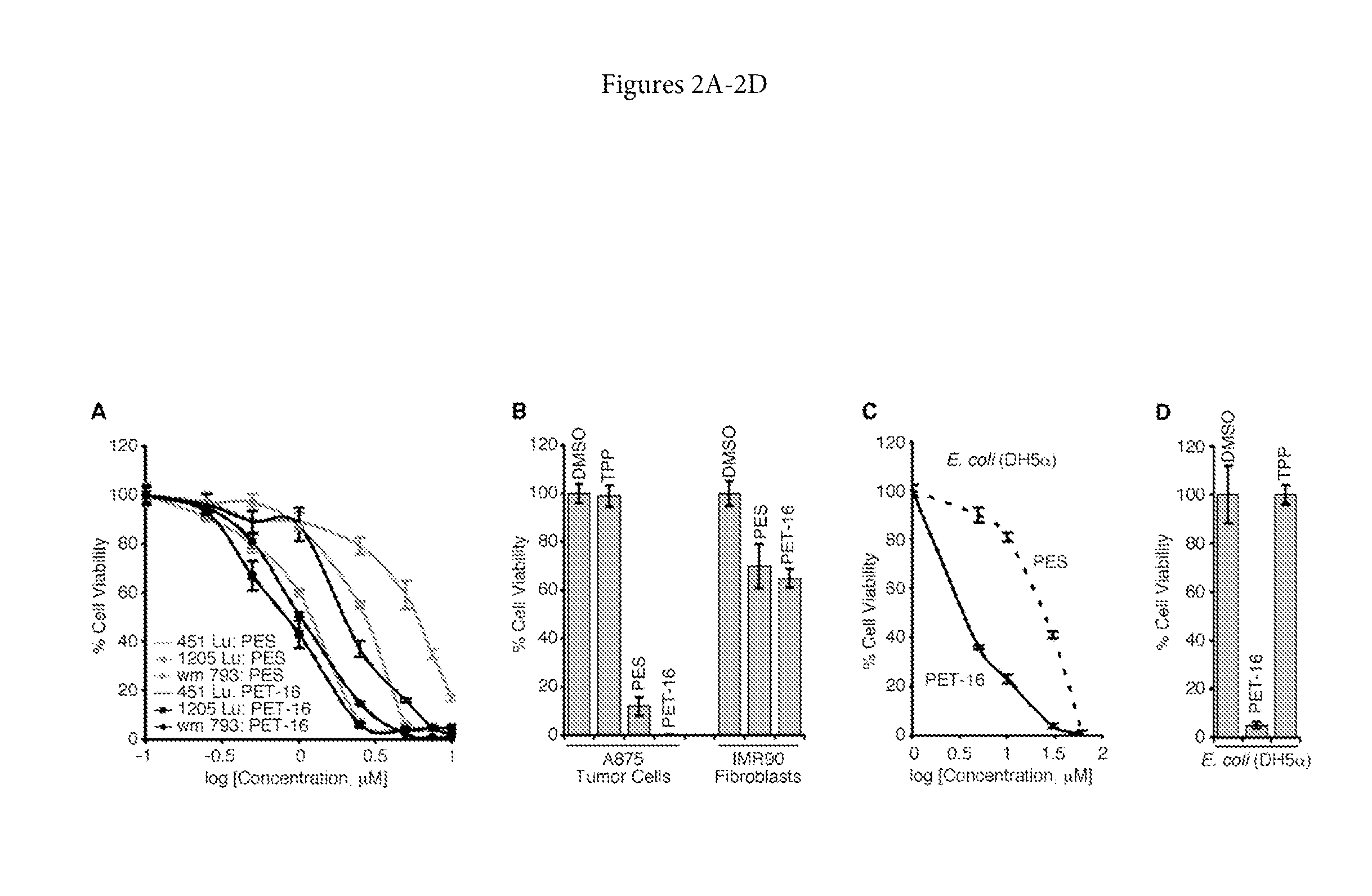Small Molecule HSP70 Inhibitors
- Summary
- Abstract
- Description
- Claims
- Application Information
AI Technical Summary
Benefits of technology
Problems solved by technology
Method used
Image
Examples
example 1
Identification of an Effective New Small Molecule Inhibitor of Mammalian HSP70 and Bacterial DnaK
[0208]Using structure-activity relationship assays, an initial small scale screen of related compounds that contain one or more moieties in common with PES / PES-Cl (FIG. 1D) was performed. This approach was informative, and pointed to the phenyl group (aromatic moiety) and acetylene linker as key features for the biological activity of these molecules (FIG. 1A).
[0209]This approach was validated and resulted in the design of two analogs that interact with HSP70. Both of these compounds exhibit cytotoxicity values in the very low μM range. One such molecule is triphenyl(phenylethynyl)phosphonium bromide (C26H20BrP; MW 443.327) referred to as PET-16 (FIG. 1E). PET-16 contains a phenyl group, an acetylene linker and a triphenylphosphine moiety (TPP). To date, no compounds containing the TPP substituent have been reported to bind selectively and directly to DnaK and HSP70.
[0210]Based on the X-...
example 2
Cell Viability Analysis Confirms that PET-16 is Preferentially Cytotoxic to Tumor Cells of Diverse Origin
[0211]It was found that concentrations of PET-16 that inhibit the viability of a broad range of tumor cell lines have little effect on non-transformed cells, such as fibroblasts or primary melanocytes (FIGS. 2A and 2B). For example, the IC50 for PET-16 in several of the melanoma cell lines examined was about 0.5-1.5 μM (FIG. 2A). In addition, because bacteria rely on a functional DnaK system to survive stresses such as elevated temperatures, the effects of PET-16 on E. coli were tested. It was found that this small molecule impaired bacterial growth (FIGS. 2C and 2D); it also caused cell filamentation and reduced viability, a phenotype that is identical to that of many DnaK mutants. In contrast, the TPP moiety alone had little discernible effect on the viability of mammalian tumor cells (FIG. 2B) and had no negative effect on the growth of E. coli (FIG. 2D).
example 3
PET-16 Directly Binds to a C-Terminal Region of HSP70 and of DnaK
[0212]To assess whether there was a direct molecular interaction between PET-16 and HSP70 / DnaK, isothermal titration calorimetry (ITC) was employed. Full-length recombinant proteins of HSP70 (aa 1-641) as well as DnaK (aa 1-638) were pretreated either with ADP or ATP, to assess the interaction of PET-16 with different nucleotide-bound states of the protein. In addition to PET-16, PES and a well-studied, synthesized client protein peptide (NRLLLTG—SEQ ID NO: 7) of HSP70 / DnaK, previously shown to complex with a defined canonical substrate binding pocket of the SBD were also assayed. See, Bertelsen, “Solution Confirmation of wild-type E. coli HSP70 (DnaK) Chaperone Complexed with ADP and Substrate”, PNAS, 106(21): 8471-8476 (May 26, 2009) and incorporated by reference herein.
[0213]ITC analyses revealed that the peptide and the two small molecules PES and PET-16 exhibit a strong preference for the ADP-bound forms of HSP70,...
PUM
| Property | Measurement | Unit |
|---|---|---|
| Hydrophobicity | aaaaa | aaaaa |
Abstract
Description
Claims
Application Information
 Login to View More
Login to View More - R&D
- Intellectual Property
- Life Sciences
- Materials
- Tech Scout
- Unparalleled Data Quality
- Higher Quality Content
- 60% Fewer Hallucinations
Browse by: Latest US Patents, China's latest patents, Technical Efficacy Thesaurus, Application Domain, Technology Topic, Popular Technical Reports.
© 2025 PatSnap. All rights reserved.Legal|Privacy policy|Modern Slavery Act Transparency Statement|Sitemap|About US| Contact US: help@patsnap.com



